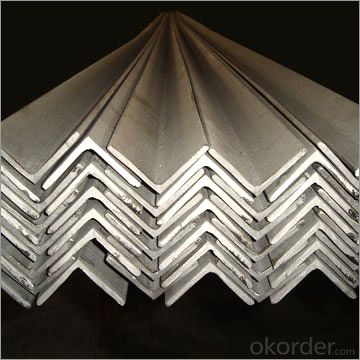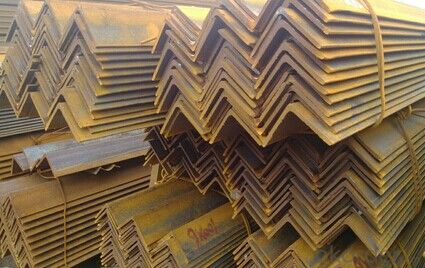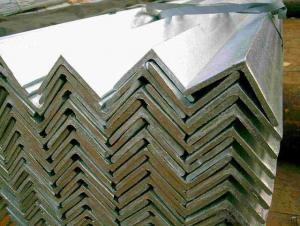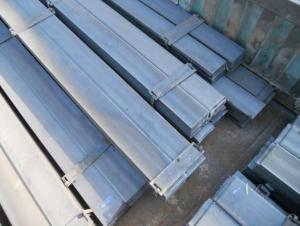SS400 galvanized angle steel for construction
- Loading Port:
- Tianjin
- Payment Terms:
- TT OR LC
- Min Order Qty:
- 25 m.t.
- Supply Capability:
- 10000 m.t./month
OKorder Service Pledge
OKorder Financial Service
You Might Also Like
Product Description:
1. Structure of Steel Equal Angle Bar Description:
Steel equal angle bar is a main kind of structure steel and the section is like a letter L. We use steel equal angle bar for tower construction. Steel equal angle bar can be erected as soon as the materials are delivered on site. High strength, stiffness, toughness, and ductile properties are advantages of this kind of steel equal angle bar.
2. Main Features of Steel Equal Angle Bar:
• Strength - Having high strength, stiffness, toughness, and ductile properties, structural steel is one of the most commonly used materials in commercial and industrial building construction.
• Constructability - Steel equal angle Bar can be developed into nearly any shape, which are either bolted or welded together in construction. Structural steel can be erected as soon as the materials are delivered on site, whereas concrete must be cured at least 1–2 weeks after pouring before construction can continue, making steel a schedule-friendly construction material.
• Fire resistance - Steel is inherently a noncombustible material. However, when heated to temperatures seen in a fire scenario, the strength and stiffness of the material is significantly reduced. The steel equal angle bar can be enveloped in sufficient fire-resistant materials, increasing overall cost of steel structure buildings.
3. Steel Equal Angle Bar Images:


4. Steel Equal Angle Bar Specification:
Angle | KG/M | Angle | KG/M | Angle | KG/M | Angle | KG/M |
20X20X3 | 0.889 | 60X60X5 | 4.570 | 90X90X8 | 10.946 | 130X130X12 | 23.600 |
20X20X4 | 1.145 | 60X60X6 | 5.427 | 90X90X9 | 12.220 | 130X130X13 | 25.400 |
25X25X2 | 0.763 | 63X63X4 | 3.907 | 90X90X10 | 13.476 | 130X130X14 | 27.200 |
25X25X3 | 1.124 | 63X63X5 | 4.822 | 90X90X15 | 15.940 | 130X130X16 | 30.900 |
25X25X4 | 1.459 | 63X63X6 | 5.721 | 100X100X6 | 9.366 | 140X140X10 | 21.488 |
30X30X2 | 0.922 | 63X63X8 | 7.469 | 100X100X7 | 10.830 | 140X140X12 | 25.522 |
30X30X3 | 1.373 | 63X63X10 | 9.151 | 100X100X8 | 12.276 | 140X140X14 | 29.490 |
30X30X4 | 1.786 | 70X70X4 | 4.372 | 100X100X10 | 15.120 | 140X140X15 | 31.451 |
36X36X3 | 1.656 | 70X70X5 | 5.397 | 100X100X12 | 17.898 | 140X140X16 | 33.393 |
5. FAQ
We have organized several common questions for our clients,may help you sincerely:
①How about the corrosion of the products?
When the steel equal angle bar in contact with water, can corrode, creating a potentially dangerous structure. Measures must be taken in structural steel construction to prevent any lifetime corrosion. The steel can be painted, providing water resistance. Also, the fire resistance material used to envelope steel is commonly water resistant.
②How to inspect the quality?
We have a professional inspection group which belongs to our company. We resolutely put an end to unqualified products flowing into the market. At the same time, we will provide necessary follow-up service assurance.
③What is the difference between steel angle bar and traditional material?
Steel equal angle bar differs from concrete in its attributed compressive strength as well as tensile strength.
- Q:Can steel angles be used for fencing or security applications?
- Yes, steel angles can be used for fencing or security applications. Steel angles provide strong structural support and can be welded or bolted together to create a secure and durable fence or security barrier. The angular shape of steel angles also adds an additional layer of strength and stability, making them suitable for such applications.
- Q:Can steel angles be used in high-temperature environments?
- Yes, steel angles can be used in high-temperature environments. Steel is known for its high strength and resistance to heat, making it suitable for applications in high-temperature settings. However, it is important to consider the specific grade and composition of the steel angle to ensure it can withstand the desired temperature range without losing its structural integrity.
- Q:How are steel angles protected against atmospheric corrosion?
- Steel angles are protected against atmospheric corrosion through various methods such as galvanization, which involves coating the steel with a layer of zinc to create a barrier against moisture and oxygen. Other protective measures include applying paint or other protective coatings to the surface of the steel angles, which act as a barrier against the corrosive elements in the atmosphere. Regular maintenance and inspection also play a crucial role in identifying and addressing any signs of corrosion, ensuring the longevity and structural integrity of the steel angles.
- Q:Can steel angles be used for bracing?
- Yes, steel angles can be used for bracing. Steel angles are commonly used as structural supports to provide strength and stability in various applications, including bracing in construction and engineering projects. Their L-shaped design allows them to distribute forces and resist bending, making them suitable for bracing purposes.
- Q:Are steel angles magnetic?
- Steel angles possess magnetic properties as they are made of steel, a ferromagnetic material. Ferromagnetic materials, like steel, can be magnetized and are drawn towards magnets. Due to the composition of steel, which includes iron and other elements, it exhibits a magnetic response. This characteristic finds practical applications in diverse fields, including construction, where steel angles are frequently employed to provide structural support.
- Q:Can steel angles be used in window frames?
- Indeed, window frames can incorporate steel angles. These steel angles find frequent application in construction, offering both structural reinforcement and stability to window frames. They often serve as reinforcements or brackets, connecting the window frame to the wall or other elements of the window system. Steel angles possess remarkable durability, strength, and resistance to corrosion, rendering them an excellent option for window frame construction. Moreover, steel angles can be effortlessly tailored and fabricated to suit various window sizes and designs.
- Q:Can steel angles be used for vehicle frames?
- Yes, steel angles can be used for vehicle frames. Steel angles are commonly used in the construction industry for their structural strength and versatility. They have a wide range of applications, including the construction of vehicle frames. Steel angles provide excellent support and stability, making them ideal for bearing heavy loads and withstanding the various stresses and forces experienced by a vehicle during operation. Additionally, steel angles can be easily welded or bolted together, allowing for flexibility in the design and construction of vehicle frames. Overall, steel angles are a reliable and durable choice for vehicle frames, ensuring the structural integrity and safety of the vehicle.
- Q:Can steel angles be used in solar panel installations?
- Yes, steel angles can be used in solar panel installations. Steel angles are commonly used as a structural support in various construction projects, including solar panel installations. They provide stability and strength to the solar panel system, ensuring that the panels are securely fixed to the ground or the mounting structure. Steel angles are durable and resistant to environmental factors, making them suitable for outdoor applications. Additionally, steel angles can be easily customized and fabricated to meet the specific requirements of the solar panel installation, allowing for flexibility and versatility in design.
- Q:How do you calculate the shear strength of a steel angle?
- To calculate the shear strength of a steel angle, you need to consider the properties of the material and the geometry of the angle. The shear strength is a measure of the maximum load that the angle can withstand before it fails under shear stress. First, you need to determine the cross-sectional area of the steel angle. This can be calculated by multiplying the thickness of the angle by the length of one side. For example, if the angle has a thickness of 0.25 inches and a length of 4 inches, the cross-sectional area would be 1 square inch (0.25 inches x 4 inches). Next, you need to determine the shear stress that the angle can withstand. This is typically provided by the manufacturer and is given as a maximum value in pounds per square inch (psi) or megapascals (MPa). For example, let's say the shear stress is given as 30,000 psi. To calculate the shear strength, you simply multiply the cross-sectional area by the shear stress. Using the example values, the shear strength would be 1 square inch x 30,000 psi = 30,000 pounds. It is important to note that this calculation assumes the angle is loaded in a single shear plane and that the material is homogenous and isotropic. In real-world applications, there may be additional factors to consider, such as the presence of holes, welds, or other stress concentrations. In these cases, more complex calculations or testing may be required to determine the shear strength accurately.
- Q:Can steel angles be bent or formed?
- Yes, steel angles can be bent or formed. Steel angles are commonly used structural elements that are made from steel and have an L-shaped cross-section. They can be bent or formed using various methods such as hot or cold bending, rolling, or press-braking. The specific method used will depend on factors such as the desired angle, radius of bending, and the thickness and type of steel being used. Bending or forming steel angles allows for the creation of different shapes and angles to suit specific structural or design requirements.
1. Manufacturer Overview |
|
|---|---|
| Location | |
| Year Established | |
| Annual Output Value | |
| Main Markets | |
| Company Certifications | |
2. Manufacturer Certificates |
|
|---|---|
| a) Certification Name | |
| Range | |
| Reference | |
| Validity Period | |
3. Manufacturer Capability |
|
|---|---|
| a)Trade Capacity | |
| Nearest Port | |
| Export Percentage | |
| No.of Employees in Trade Department | |
| Language Spoken: | |
| b)Factory Information | |
| Factory Size: | |
| No. of Production Lines | |
| Contract Manufacturing | |
| Product Price Range | |
Send your message to us
SS400 galvanized angle steel for construction
- Loading Port:
- Tianjin
- Payment Terms:
- TT OR LC
- Min Order Qty:
- 25 m.t.
- Supply Capability:
- 10000 m.t./month
OKorder Service Pledge
OKorder Financial Service
Similar products
New products
Hot products
Hot Searches
Related keywords


































